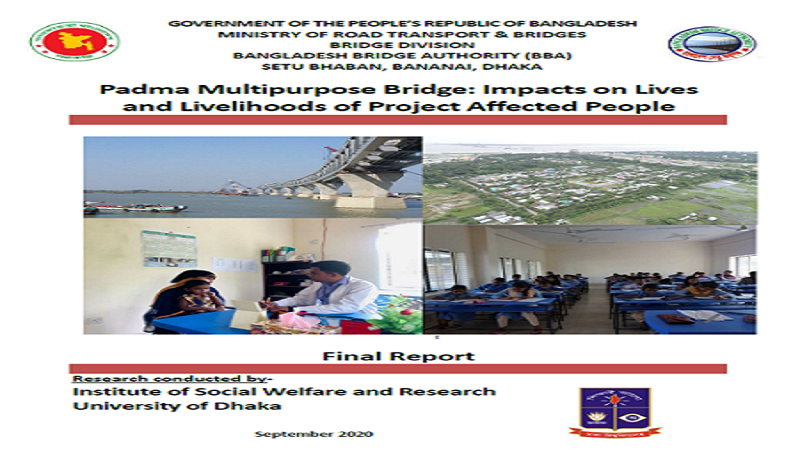
Padma Multipurpose Bridge: Impacts of Lives and Livelihoods of Affected People
The Padma Multipurpose Bridge Project (PMBP) is one of the significant development projects in Bangladesh. This bridge will provide direct connectivity between the central and southwestern parts of the country through a fixed link on the Padma River at Mawa-Zanjira points. The bridge will contribute significantly towards facilitating the social, economic, and industrial development of this relatively underdeveloped region with a total population of over 30 million. The project is viewed as a very important infrastructure towards improving the transportation network and regional economic development of the country. This bridge gives special attention to the developments during construction and post-construction period and outlines the objectives, policy, principles, and procedures for acquisition and requisition of land and involuntary resettlement, compensation and other assistance measures, and procedures for the preparation of additional safeguard for issues identified during project implementation. The bridge has provisions for rail, gas, electric line, and fiber optic cable for future expansion. The project has been fully financed by the Government of Bangladesh (GoB).
The objective of this research was to know the current lives and livelihoods status on demographic, socioeconomic, and psychological conditions of the affected population of the Padma Multipurpose Bridge; understand the impacts of current education, health, training, and income generation activities (IGA programs); know the kinship development among the migrated people to other places; know the changing livelihood patterns and livelihood options and compare with baseline findings; explore their psychosocial and natural vulnerabilities, migration and displacement, their coping strategies, social adaptation, community resilience and the impacts of recovery processes taken by PMB project; determine/measure the gaps of services (demand and supply delivery system), and know the further directions towards their future betterment.
This study employed a mixed-method approach to collect both quantitative and qualitative data where a social survey method for quantitative and a case study for qualitative were used. Data were collected from 11 Unions from four Upazila in three districts of the Padma Multipurpose Bridge Project affected households (settlement and non-settlement). These Louhajong and ShireenagorUpazilas in the Munshiganj District; ZajiraUpazila in the Shariatpur District and ShibcharUpazila in the Madaripur District. A total of 5,076 households (1,596 households from settlement and 3,480 households from non-settlement) were selected for data collection from the total 7,638 households. On average, it is nearly 66% of the total households in those four Upazilas. A total of 100 households were also chosen from outside of the project area as a control group who are considered as non-affected areas. A well-structured face-to-face interview schedule was used to collect quantitative data from the selected household heads. The FGDs, in-depth case study, KIIs, and community mapping were conducted with relevant stakeholders such as community leaders, project teams, relevant NGOs, government officials, and line departments, etc.
This report provided an ample literature review with a brief but pulsating theoretical framework and showed how the research outcomes/findings possessed. The results section provided field findings on 12 main lives and livelihood indicators in light of the research objectives and research questions. These 12 indicators are i) economic status, ii) infrastructures, iii) residence, water sources, latrine and sanitation, iv) education and health, v) damages, service received, and service demands, vi) food security, social service, and social security, vii) women empowerment, viii) vulnerability, ix) migration and social mobility, x) livelihood choices and competencies, xi) strategies to face environment, climatic change and vulnerabilities, and positive impacts of PMBP on the lives and livelihoods including demographic information of the households. Findings are presented in the different types of tables and figures with major relevant statistical applications considering three main household categories such as settlement, non-settlement, and outside households with overall averages. However, the findings provided a clear comparison between the category of stakeholders on one hand, and to see the overall average and total on the other.